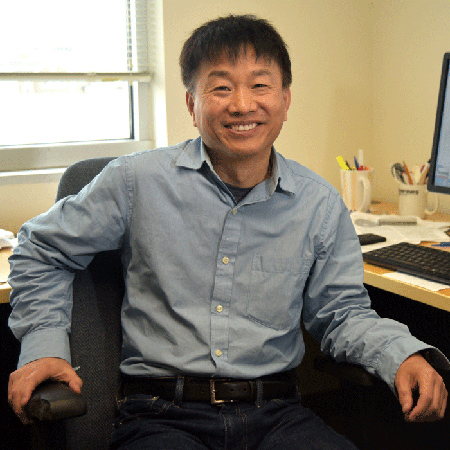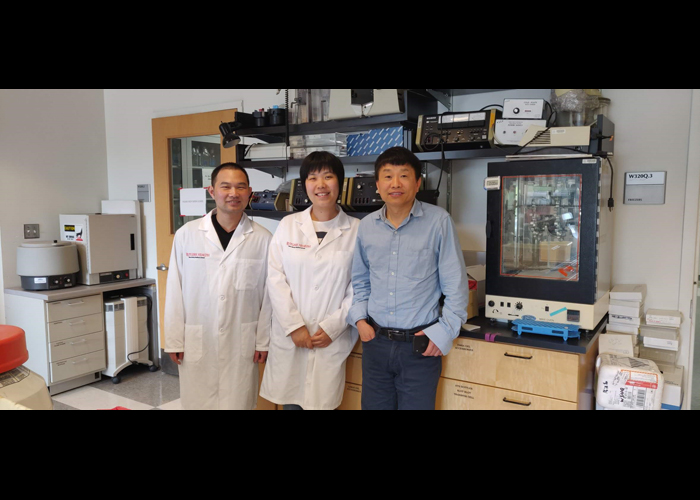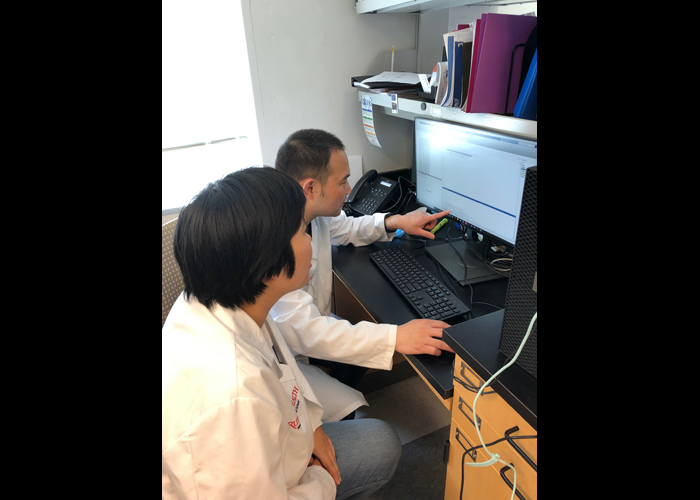
Lanbo Shi, Ph.D.
Assistant Professor of Medicine
shila@njms.rutgers.edu |
Office: Room W310P Phone: +(1)973-854-3320
Lab: Room W310Q Phone: +(1)973-854-3322
Tuberculosis (TB), caused by Mycobacterium tuberculosis (Mtb), has become world’s leading killer from infectious diseases, with an estimated 1.8 million deaths each year. TB results from complex host-pathogen interactions and its pathological hallmark is the formation of lung granulomas. After successful pulmonary infection, Mtb survives and proliferates within macrophages until the expression of a delayed adaptive immunity with the formation of granulomas, which eventually controls growth of the pathogen. While granuloma is able to localize and contain Mtb by concentrating the immune response, recent studies also indicate that Mtb has evolved the ability not only to adapt to the hostile environment but also to exacerbate the pathological manifestations in granulomas, ultimately resulting in progression of the infection and bacillary dissemination.
Dr. Shi’s lab is interested in understanding the interrelationship between the bioenergetic pathways of host immune cells and their specific immune functions in TB. Recent findings from his group indicate that host immune cells switch to utilize aerobic glycolysis (aka, the Warburg effect in cancer cells) as carbon and energy source in response to Mtb infection, and this metabolic reprogramming is associated with induction of the Hypoxia Inducible Factor 1 (HIF-1), a master transcription regulator of genes involved in multiple cellular adaptation processes including energy metabolism. Increasing evidence indicates that the HIF-1-mediated Warburg effect is required for immune cells to mount an efficient antimicrobial and pro-inflammatory response against Mtb, and that the pathogen modulates the metabolic reprogramming of host immune cells as mechanism of pathogenicity. Using multiple approaches including protein immunofluorescence and single molecule RNA-FISH his group is dissecting the metabolic determinants of immune cell functions in association with different infection outcome. Elucidation of host immunometabolism in TB is expected to illuminate avenues for the development of host-directed therapies (HDT) to enhance the antimicrobial functions of immune cells by “tailoring” their metabolism.
The Shi lab also studies mechanisms of Mtb survival and persistence during infection. His early studies involve in the characterization of several important metabolic and physiological adaptations of Mtb in response to host adaptive immunity, which include induction of the DosR dormancy regulon, shift of the respiratory pathways from energy-efficient aerobic pathway to anaerobic respiration, and rerouting of carbon flux from cell growth-associated biosynthetic precursors toward the formation of triacylglycerol (TAG), a storage compound that serves as carbon and energy source during Mtb persistence and reactivation. His group also studies the little-known molecular mechanism of Mtb reactivation from dormancy. A recent profiling of transcriptome dynamics of the reactivating bacilli from hypoxia-induced dormancy revealed that a transcriptome reprogramming in the Mtb lag phase orchestrates the recovery of metabolic and physiological functions leading to the eventual resumption of bacterial replication. Especially, the identification of a number of up-regulated transcription regulons and metabolic pathways in the lag phase underscores potential therapeutic intervention checkpoints to prevent Mtb from reactivating.
Kumar R, Kolloli A, Subbian S, Kaushal D, Shi L, Tyagi S (2024) Imaging the Architecture of Granulomas Induced by Mycobacterium tuberculosis Infection with Single-molecule Fluorescence In Situ Hybridization. J Immunol. PMI: 38912840
Jiang Q, Qiu Y, Kurland IJ, Drlica K, Subbian S, Tyagi S, Shi L (2022) Glutamine Is Required for M1-like Polarization of Macrophages in Response to Mycobacterium tuberculosis Infection. mBio 13: e0127422. PMI: 35762591
Jiang Q, Linn T, Drlica K, Shi L (2022) Diabetes as a potential compounding factor in COVID-19-mediated male subfertility. Cell Biosci 12: 35. PMI: 35307018
Ma MT, Badeti S, Chen CH, Kim J, Choudhary A, Honnen B, Reichman C, Calianese D, Pinter A, Jiang Q, Shi L, Zhou R, Xu H, Li Q, Gause W, Liu D (2021) CAR-NK Cells Effectively Target SARS-CoV-2-Spike-Expressing Cell Lines In Vitro. Front Immunol 12: 652223. PMI: 34367128
Jiang Q, Shi L (2021) Coordination of the Uptake and Metabolism of Amino Acids in Mycobacterium tuberculosis-Infected Macrophages. Frontiers in Immunology 12.
Jiang Q, Maresch CC, Petry SF, Paradowska-Dogan A, Bhushan S, Chang Y, Wrenzycki C, Schuppe HC, Houska P, Hartmann MF, Wudy SA, Shi L, Linn T (2020) Elevated CCL2 causes Leydig cell malfunction in metabolic syndrome. JCI Insight 5. PMI: 33148888
Kumar R, Singh P, Kolloli A, Shi L, Bushkin Y, Tyagi S, Subbian S (2019) Immunometabolism of Phagocytes During Mycobacterium tuberculosis Infection. Frontiers in Molecular Biosciences 6
Shi L, Jiang Q, Bushkin Y, Subbian S, Tyagi S (2019) Biphasic Dynamics of Macrophage Immunometabolism during Mycobacterium tuberculosis Infection. MBio 10. PMI: 30914513
Shi L, Eugenin EA, Subbian S (2016) Immunometabolism in Tuberculosis. Front Immunol 7: 150. PMI: 27148269
Giffin MM, Shi L, Gennaro ML, Sohaskey CD (2016) Role of Alanine Dehydrogenase of Mycobacterium tuberculosis during Recovery from Hypoxic Nonreplicating Persistence. PLoS One 11: e0155522. PMI: 27203084
Du P, Sohaskey CD, Shi L (2016) Transcriptional and Physiological Changes during Mycobacterium tuberculosis Reactivation from Non-replicating Persistence. Front Microbiol 7: 1346. PMI: 27630619
Shi L, Salamon H, Eugenin EA, Pine R, Cooper A, Gennaro ML (2015) Infection with Mycobacterium tuberculosis induces the Warburg effect in mouse lungs. Sci Rep 5: 18176. PMI: 26658723
Salamon H, Bruiners N, Lakehal K, Shi L, Ravi J, Yamaguchi KD, Pine R, Gennaro ML (2014) Cutting edge: Vitamin D regulates lipid metabolism in Mycobacterium tuberculosis infection. J Immunol 193: 30-34. PMI: 24899504
Datta P, Shi L, Bibi N, Balazsi G, Gennaro ML (2011) Regulation of central metabolism genes of i by parallel feed-forward loops controlled by sigma factor E (sigma(E)). J Bacteriol 193: 1154-1160. PMI: 21193605
Shi L, Sohaskey CD, Pfeiffer C, Datta P, Parks M, McFadden J, North RJ, Gennaro ML (2010) Carbon flux rerouting during Mycobacterium tuberculosis growth arrest. Mol Microbiol 78: 1199-1215. PMI: 21091505
Hussain S, Malik M, Shi L, Gennaro ML, Drlica K (2009) In vitro model of mycobacterial growth arrest using nitric oxide with limited air. Antimicrob Agents Chemother 53: 157-161. PMI: 18955516
Shi L, Sohaskey CD, North RJ, Gennaro ML (2008) Transcriptional characterization of the antioxidant response of Mycobacterium tuberculosis in vivo and during adaptation to hypoxia in vitro. Tuberculosis (Edinb) 88: 1-6. PMI: 17928268
Balazsi G, Heath AP, Shi L, Gennaro ML (2008) The temporal response of the Mycobacterium tuberculosis gene regulatory network during growth arrest. Mol Syst Biol 4: 225. PMI: 18985025
Shi L, Sohaskey CD, Kana BD, Dawes S, North RJ, Mizrahi V, Gennaro ML (2005) Changes in energy metabolism of Mycobacterium tuberculosis in mouse lung and under in vitro conditions affecting aerobic respiration. Proc Natl Acad Sci U S A 102: 15629-15634. PMI: 16227431
Davidow A, Kanaujia GV, Shi L, Kaviar J, Guo X, Sung N, Kaplan G, Menzies D, Gennaro ML (2005) Antibody profiles characteristic of Mycobacterium tuberculosis infection state. Infect Immun 73: 6846-6851. PMI: 16177363
Shi L, North R, Gennaro ML (2004) Effect of growth state on transcription levels of genes encoding major secreted antigens of Mycobacterium tuberculosis in the mouse lung. Infect Immun 72: 2420-2424. PMI: 15039373
Shi L, Jung YJ, Tyagi S, Gennaro ML, North RJ (2003) Expression of Th1-mediated immunity in mouse lungs induces a Mycobacterium tuberculosis transcription pattern characteristic of nonreplicating persistence. Proc Natl Acad Sci U S A 100: 241-246. PMI: 12506197



